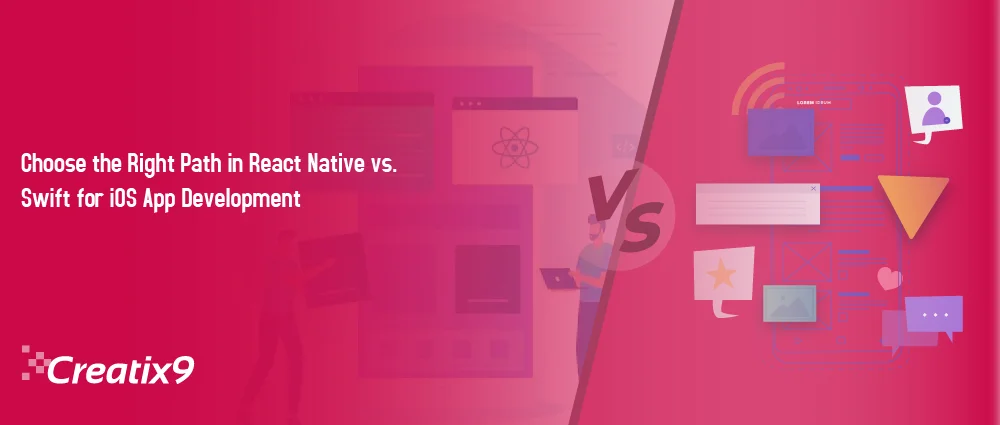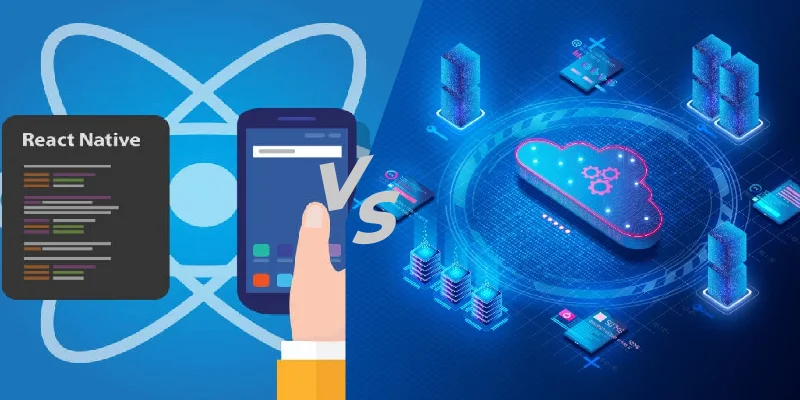
Decide on the correct technology stack for your iOS app development may seem easy. But it’s not always a simple choice. Native apps may not always be the ideal option. What if your project benefits more from a cross-platform solution? Could it be more cost-effective to go for React Native rather than Swift? So, let’s see the sights whether react Native or Swift is the good tech for constructing your iOS app.
In a nutshell, if your iOS app features a simple UI and lacks complex logic, React Native can be the ideal choice. If speed-to-market and cost reduction are all your concerns, still this framework is a better option.
On the other hand, opt for Swift when your app is intricate. It requires fully utilizing the device’s capabilities and demands compatibility with all Apple products. Swift is the preferred option when budget constraints are not a major limitation.
React Native vs. Swift: Battle Between Cross-platform and native app

When picking between React Native and Swift, you decide between cross-platform and native apps. Which path should you take? Should you create a native app using Swift or a cross-platform app via React Native? Let’s probe into what these mobile development approaches have to come.
Building Cross-platform app Via React Native

React Native merges the React JavaScript library with elements of native development, providing a distinct advantage: the ability to create apps for multiple platforms. But that’s not all; the framework offers several noteworthy advantages:
Code reusability: Amazingly, you can use again up to 90% of React Native code among iOS and Android apps. You can have create several apps rapidly.
Cost-effectiveness. Cross-platform mobile app development is financially efficient. It gives not just one but multiple apps. You can have large savings, as hiring a separate team for an Android apps is needless. Besides, native iOS developers often command high salaries, while cross-platform mobile developers generally charge less.
A sizable developer community: Creating a team of developers for a mobile app that works on different platforms is simpler with this framework. It uses JavaScript, which is more widely used than Swift. So, finding developers to build a React Native app should be easy.
Supports the creation of web applications: This opens the door to realizing a developer’s dream: a universal app. However, it’s worth noting that this can be challenging, as React Native’s web app development is still somewhat immature.
Building Native App vs. Swift
Simply put, Swift is the go-to solution for iOS app development. The logic behind this first choice is the advantages that come with native app development:
First, Swift apps are tailor-made for iOS; they give brilliant performance and a smooth user experience.
With Native development in Swift, you can access to native APIs Hardware Integration, UI, ARKit and Core ML, Integration with Other Native Apps security, Multitasking features (background processing, push notifications, and widgets on iOS and macOS) and much more. You can create complex apps that with no issue exchange data with other native apps like Health.
Also, Swift ensures compatibility across the entire spectrum of Apple’s products. Whether it’s Apple TVs, iPhones, Apple Watches, Macs, or iPads, Swift let develop apps that run smoothly on all these devices.
8 Criteria to Create Swift Vs. React Native
Now, let’s associate the creation of Swift and React Native apps per these eight criteria:
- Testing
First is that React Native comes with multiple testing methods for diverse levels of testing. Component testing can be done using ReactTestUtils, while Jest or Jasmine are suitable for unit testing. Jest is by design built-in in every React Native app during initialization. For integration testing, options like Mocha or RNtester.
React Native is compatible with popular test automation frameworks, allowing you to test iOS apps using XCTest, Apple’s testing framework. XCTest supports performance tests, unit tests, and UI tests. Also, you can utilize the Keep It Functional (KIF) framework for iOS functional testing. Robot and Appium Framework are also viable choices for test automation.
In the case of a Swift app, Xcode’s XCTest framework can be employed to run UI tests. With XCTest, you can merely build test cases when you record your interactions with the app, which are automatically translated into code. However, it may require more assertions to ensure accuracy. Apart from XCTest, other Swift app testing options are Appium, Jasmine, EarlGrey, Jest, and Calabash.
- APIs and Third-party libraries

React Native’s community is steadily expanding, leading to a proliferation of third-party libraries catering to various app development aspects. For instance, when it comes to interfacing with native components, the modern iterations of React Native have adopted Yarn as a package manager, simplifying the installation and management of dependencies.
Furthermore, linking third-party libraries involving native code has become automatic within the framework, starting from React Native version 0.60. This means that, in most cases, manual linking of libraries in Xcode or the execution of separate commands is no longer necessary.
Similarly, in the case of Swift, a wealth of iOS open-source libraries and APIs exists. It comes with an all-in-one approach to handle third-party libraries. You can easily enhance your development toolkit via Carthage and CocoaPods.
- Building enterprise apps
React Native creates problems for building large-scale enterprise applications as JavaScript does not support type-checking. As the app expands, the lack of type safety becomes more troublesome and limits scalability. Furthermore, when refactoring an enterprise-grade React Native application, such as renaming props, there can be challenges. Another possible way to address these problems is by bringing TypeScripts in, an action that involves more time and knowledgeable software engineers.
However, when it comes to enterprise-level applications, Swift’s concise syntax is more suitable. It simplifies the management aspect for large-scale applications by enabling developers to write less code. Swift, too, have many valuable features that are ideal for enterprise projects— a protocol-oriented architecture, powerful memory management, flexible types, and an efficient error-handling mechanism.
- Over-the-air (OTA) updates
However, you may be aware that Apple disapproves of over-the-air (OTA) app updates. On the other hand, with React Native, it is possible to make some minor changes and release the updated app through the App Store without resubmitting it. CodePush, designed to update JavaScript code, can achieve this.
However, you can also try Electrode, which could serve as another option. That said, it is crucial to be cautious not to change the primary aim of your app when using OTA updates in such a way.
However, the possibility of getting OTA updates is not presented in relation to a Swift-based app. In such instances, you need to create a new app version and submit it to the store for approval and implementation of the updates.
- CI/CD support
Unfortunately, React Native lacks a prepackaged solution for CI/CD. You may have to resort to third-party solutions to automate the delivery process. Create Your Own CI/CD Pipeline for React Native— Bitrise, NeverCode, Fastlane, and CircleCI.
You can create an end-to-end CI/CD pipeline for a Swift app using tools like Bitrise, TravisCI, Buddybuild, and CircleCI. It must be mentioned that there is a beta status of Fastlane’s setup for Swift and limited functions of NeverCode for Swift apps.
- UI
React Native uses JavaScript bridge to render the native iPhone components, so it’s a native-like UI for react native applications. One benefit that Native has over other technologies is a lot of pre-built components. Nonetheless, the behavior of these components can be unpredictable in some situations and might hinder the react-native’s capacity to compete effectively with Swift in interface development.
On the other hand, Swift easily interacts with the IOS platform, making it much easier to develop attractive UIs for local apps that are far better than what React Native provides. In addition, recent advancements have made this process even more feasible. A new Swift framework called SwiftUI was announced at WWDC 2019, allowing developers to build the user interface of an app in a declarative manner. This added to the strength of Swift.
- Security
However, in ReactNative, the AsyncStorage API is active; for good reason, one would need an additional level of abstraction. That is why AsyncStorage does not have any encryption, as it is global.
Here are some advice for using AsyncStorage:
- When storing non-sensitive data, go for async storage to store the Redux and GraphQL states or keep global app-wide variables alive across app sessions.
- Do not use async storage for sensitive information such as tokens and secrets.
Many developers usually rely on third-party libraries for strong data security in a React Native app take in:
- React-native-sensitive-info: Manages the storage of important information.
- React-native-secure-storage: Standard Library for Secure Data Storage.
- React-native-keychain: Safeguarding Serious Information like User Login Credentials.
Besides, Apple has its own app security techniques—authorization, authentication, secure data handling, code signing, and encryption. Some notable ones are:
- Randomization Services that produce a cryptographically strong set of random number generations.
- Secured data integrity via encryption and syntax services for cryptographic messages. Particularly important to this type of apps where messages must be processed within store-and-forward systems like Email.
- The iOS Common Crypto Library coms with basic tools for adding strong security features to Swift apps on iOS like encrypting data using the Advanced Encryption Standard (AES) to confirm secure storage of sensitive information.
- KeyChain Services API for securing the storage of passwords, private key data, and so much more.
- App maintenance
React Native encounters challenges related to code updates and compatibility with third-party libraries. Whenever a new framework release is introduced, it necessitates verifying whether the updated React Native version is compatible with each library version within your app. This process can be quite cumbersome and frustrating. Additionally, React Native grapples with numerous unresolved issues.
In contrast, Swift, a statically typed language, offers a smoother maintenance experience than JavaScript. Developers can rely on XCode, simplifying identifying errors during Swift mobile app development. Swift is a concise language requiring less code to perform the same tasks as Objective-C. This compactness ensures that app maintainability is never a concern when working with Swift.
Apps built with React Native vs. Swift:
You might already have well-known React Native apps on your mobile device: Facebook, Walmart, Facebook Ads Manager, Pinterest, Oculus, Tesla, Skype, and Instagram. While iOS applications are crafted using Swift, they are Khan Academy, Kickstarter, LinkedIn, Lyft, Firefox, VSCO, and WordPress.
Blog Windup…
Both React Native and Swift are excellent tools for iOS app development. Using their unique features is vital to decide which is more suitable for your project.
React Native can let you create iOS, Android, and web apps with single codebase. It makes a cost-effective choice with the development of high-quality apps. However, one drawback is its relative immaturity. A lack of comprehensive documentation and recurrent framework updates can pose challenges. On the bright side, React Native was initially designed for iOS development, reducing the chance of come across big issues.
While, Swift is a precise and concise programming language— suited for larger enterprise apps than React Native? You can develop an iOS app with Swift more rapidly than using React Native. Yet, if you intend to create a native Android app, it will require more time and resources. Opting for Swift guarantees clear code, a rich user experience, and smooth performance.
If you’re in search of building a React native app or Swift app, reach out to Creatix9— an affordable app development company in the US. Get support from us for your next mobile app project.
Also, we are a professional digital agency that can market your app. Visit our site and receive the best possible quote.

